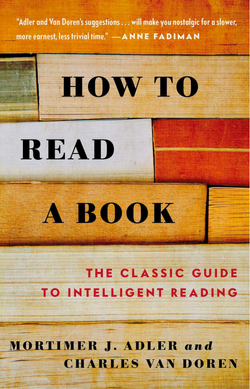The idea for this article came to me as I was reading the original book on
Summary
"How to Read a Book: The Ultimate Guide" by Mortimer Adler provides readers with an insightful and systematic approach to effectively and thoroughly reading books. The critical points of Adler's guide are as follows:
Key Takeaways
Reading levels
Adler identifies four levels of reading, each more advanced than the previous one:
- Elementary reading
- Inspectional reading
- Analytical reading
- Syntopical reading
Inspectional reading
This level involves skimming and superficial reading to understand the book's content and structure. It includes:
- Reading the title, preface, and table of contents
- Skimming through chapters and headings
- Reading the summary or conclusion
Analytical reading
A deeper, more thorough reading of the book focused on understanding the author's ideas and arguments. It entails:
- Identifying the book's central theme and subsidiary points
- Understanding the author's arguments and evidence
- Critically evaluating the author's logic and persuasiveness
- Comparing the book's ideas with your knowledge and opinions
Syntopical reading
The most advanced reading level involves comparing and synthesizing ideas across multiple books on the same topic. The process includes the following:
- Identifying relevant books on the topic
- Skimming and inspectional reading to grasp each book's main points
- Analytical reading to deeply understand each book's arguments
- Comparing and contrasting the authors' ideas and insights
- Developing your perspective on the topic
- Active reading: Adler emphasizes the importance of engaging with the text, asking questions, and taking notes while reading. This helps readers better understand the material and encourages critical thinking.
- Reading different genres: Adler provides specific guidelines for reading different types of books, including fiction, history, science, philosophy, and social sciences. Each genre requires a unique approach to maximize comprehension and retention.
My Thoughts
Why read a book on "How to read a book"?
Good question. I have three reasons, to be specific.
Return on Attention
- First, reading a book is a massive commitment and investment of Time. Anyone who values Time would not want to spend Time on a book that offers little or no return on attention (RoA).
- There is an opportunity cost to choosing to read a book. The exact Time could have been used to read a book worth your Time for a much higher return on attention.
Lack of TimeTime
- The book "How to Read a Book" even though it is a classic guide. The book was written in the 1980s.
- So much has changed since then. Cultures have evolved, and social media has taken over the world. Our attention spans have sunk lower than ever before.
- I share the blame as well. After all, Time is a currency of utmost priority and importance for us all; it is the non-renewal construct humans can experience.
Technology has evolved.
- Although the reasons may not have changed, the reader, the society in which the reader lives, and the technology the reader uses have drastically changed.
- Technology has evolved beyond our wildest imagination and in more ways than one. Unlike in the 1980s, we have multiple modes of consuming the same information differently.
- We have Blinkist read the summary of the book. Then, we have a digital version of the book, such as Kindle.
- Digital format is perfect for the portability and accessibility of reading a book anytime, anywhere, while carrying millions of books in your pocket, which was impossible in the 1980s.
- Then, there is an option for audiobooks, which you can use to listen to the book instead of reading as a primary option. Then, there is the experience of reading from an actual physical copy (paperback or hardcover), depending on your preference, which is more irreplaceable than ever.
- No single way of reading is incorrect; it is all subjective and based on your preference.
- Time, cost, and environmentally friendly effective way of reading.
The framework I have laid down for reading a book in 2022 is not just for intelligent reading but also for Time- and cost-effective reading that achieves the highest RoA possible.
Workflow
Blinkist -> Kindle -> Audible -> Paperback.
The workflow may change depending on the desired level of understanding of the book based on the 4 Levels of Reading from the Original Book.
- Sample the books on Amazon. Resist the urge not to buy the book impulsively.
- Start by reading the comments- the Good, the Bad, and The Ugly- and form an Objective Opinion based on that.
- Ask yourself, What's the objective of reading the book? Am I reading to learn a skill, concept, or specialized topic? Does the Objective opinion of the book seem to fulfill that objective? If not, why not? If yes, why?
- If yes, read the book summary first on the platform or app of your choice. You can Blinkist, or you can use something else. You can also google for book summaries on YouTube and takeaways on Google for people's blogs.
- If it resonates with you, buy a Kindle version of the book.
- Create a map or structure of the book, and understand how the ideas or the topic are organized.
- Read the book's Foreward, Preface, Introduction, Prologue, and Epilogue.
- Jump on the chapter that piques your interest.
- Open the book on Kindle, and look for the Notable Clips section in X-Ray mode.
- If you want, you may read & highlight those passages throughout the book.
- Look for popular highlights and highlight them for you as well.
- If you still haven't gotten everything out of the book.
- Start reading the book from where you are most excited about it.
- Read it aloud or use Audible Narration to read and listen to it simultaneously.





